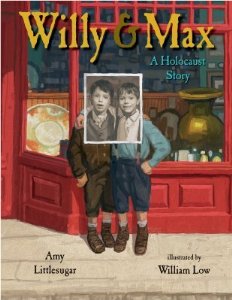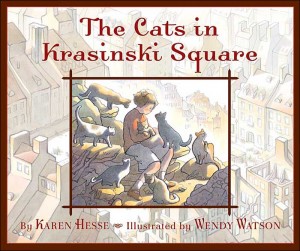I have a soft spot for picture books – many of the best have few words, carefully chosen to keep the story simple and compelling. Picture books are generally meant to be read aloud and to allow children to follow along by “reading” the pictures. It’s a brilliant concept, but the proof is in the execution, which is particularly difficult with emotionally wrenching subject matter, such as a Holocaust story. I’ve read many young adult oriented Holocaust novels, and while I haven’t found a work in that form yet that I really love, I am deeply impressed with two picture books aimed at younger children set in the middle of the history of the Holocaust.
I discovered Karen Hesse and Wendy Watson’s The Cats in Krasinski Square picture book completely by accident. I was at the public library with my sons (who were quite little at the time), and noticed a book left on the floor. Perhaps a child had pulled it out and dropped it, or maybe a parent perused it but thought the subject matter inappropriate for their child. It was just happenstance that I noticed it—One of my favorite pieces painted by my great-grandfather is titled “Krasinski Park,” so the Krasinsky in the title caught my eye.
The story centers around a young Jewish girl who lives in Nazi occupied Warsaw. She has escaped the ghetto, lives with her sister, and is passing as a non-Jew. She and her sister live alone, but work with members of the resistance to smuggle food into the Ghetto through cracks in the walls. The food generally comes to them from other members of the resistance arriving by train, smuggling food into the city in bags and satchels. One day the sisters learn the Gestapo knows about the food arriving by train. The girls must think of a way to distract the Gestapo and protect their friends and the expected food. A plan is hatched: they will collect the many abandoned cats roaming the city streets of Warsaw and bring them to the train station so that when the Gestapo arrives with their dogs to sniff out the food crates, the cats will distract and disrupt the search and the food can be retrieved. Although the backdrop of the story is sad and tragic, the story is one of courage and bravery. It is an inspiring story of daring fearlessness and a gentle introduction to the difficult subject of the Holocaust.
My other favorite Holocaust picture book is Amy Littlesugar and William Low’s Willy & Max: A Holocaust Story. The title characters are two boys whose friendship comes about when Max’s father asks Willy’s parents, who own an antique store, to hide a painting, “The Lady,” until the war is over. Willy hides the painting in a secret spot inside a statue. A few days later the Nazis arrive at the shop because they’ve heard that Jews have been in the shop and they are in search of the painting. They don’t find it, but they confiscate the sculpture because they happen to like it and want to have it for themselves. 60 years later Willy, now a grandfather living in America receives a phone call from a curator at a museum – the statue, discovered after the war in bombed out rubble of a German city had remained intact and the painting, hidden inside, was still there. On the back of the painting had been a photo of the two young boys, their names, and the phrase, “friends forever.” Willy asks the curator for help in finding Max. It takes a long time and she doesn’t actually find Max, he died the year before, but the curator does find Max’s family, and the end of the book is a reunion between the two families.
I love the book because, like Hesse’s book, it is told so lovingly and eloquently. The pictures are also lovely and even the scenes that are frightening – the Nazi soldiers and tanks in the streets, the destruction Max’s family experiences in their home – are presented in a way that’s palatable to young kids and didn’t cause mine any nightmares. It’s a well written and illustrated gem of a story, but one that has special significance to me because it is a story of looted art during the Holocaust. This is a subject that has received substantial attention in mainstream literature (though never as much as I would like), so it’s nice to see it addressed in a child-friendly format. Children relate to the concepts of ownership and taking quite easily—“It’s mine” and “You stole it” speak to their experiences. Issues of art restitution are complex and while this book simplifies questions of art looting and provenance, it focuses on a number of central themes. Namely, that art holds deep personal and emotional significance, that people have strong connections to art, and that art connects people across time and culture. As an added bonus for me personally, this story, like my own quest, is not about famous, historically significant, or super valuable paintings, it is about family heirlooms.

